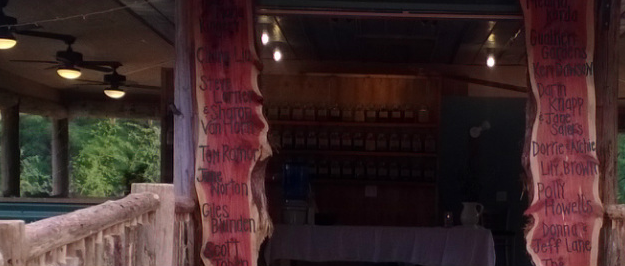CROWDFUNDED TEA HOUSE PROMOTES COMPLEMENTARY MEDICINE

Photo: Honeysuckle Teahouse
“Let food be thy medicine, and medicine be thy food.”
– Hippocrates
The wisdom of this ancient Greek physician is the first thing a visitor will come across if they visit the website of the newly launched Honeysuckle Tea House, a crowdfunded community gathering-place that sits just outside of Carrboro. The background concept for the teahouse came from two of the teachers at Pickards Mountain Eco-Institute, ethnobotanists Frank Cook and James Duke (author of The Green Pharmacy).
“Both were experts in natural remedies, in particular the benefits of herbal medicine. They drew upon ancient Chinese and Ayurvedic Medicine, which we found to be wonderfully complementary to western medicine,” explains Tim Toben, one of the founders and owners of Honeysuckle Tea House. “We hope that the HTH will provide alternative and supplemental health care from plants and fungi in a place that is healing by its own nature. The herbalists on staff have expertise in the properties of these plants and mushrooms, which have benefitted humans and other creatures for millennia.”
Local architect Giles Blunden headed up construction of the tea house, and he explains that design choices were as much about atmosphere as they were environmental sustainability:
“The reasoning and thought behind the tea house was to create a new rural destination where people can hang out and bring their children to learn and experience modern farm life….a gathering place to ‘just be’ in fresh air and away from the hum of big highways…a place to meet where the pace is slow and unhurried. And a place to just sit and smile at the richness of the natural world.”
Blunden emphasises that reclamation and reuse were still core to the whole project:
“The process of building the Honeysuckle Tea House started with the telephone poles that were taken down to become the posts to hold up the roof.”
According to Toben, almost all of the materials used for the tea house were pre-loved in some form or another:
“Most of the materials in HTH are recycled or repurposed and would otherwise be occupying landfills, if not for this ‘second life’. The used shipping containers that make up the first floor were recovered from the Norfolk Shipyard. The tin on the ceiling came off a 70-year old farmhouse on the property. The rails were discarded from a demolished porch in Chapel Hill. We wanted to help minimize landfill waste and show that used materials are valuable and useful well beyond their initial purpose. This is the hallmark of a Giles Blunden design.”
One of the side benefits of eprioritizing reuse and craftsmanship, says Blunden, is a building that feels part of the landscape already:
“This all makes for a building that seems to have been there all along. We also sourced a lot of materials, doors, wood, and tile, from the The ReUse Warehouse in Durham, a wonderful company that specializes in repurposing building materials.”
The tea house is designed to offer a holistic experience, even providing a pick-your-own tea option. The plants are all germinated, grown, and harvested at Honeysuckle Tea House.
From the big screen porch with ceiling fans to the tunnels for children to crawl through, or the bridge crossing the pond, the idea is to create a space where people want to spend time, explore, get to know each other, and rekindle community, says Toben:
“The place is a sanctuary that will offer rest and education, 16 acres for children to explore and play, and a beautiful place for friends and colleagues to gather and for new alliances to be forged. We believe that it will be another nexus for development of resilience — both at the individual and the community level.”